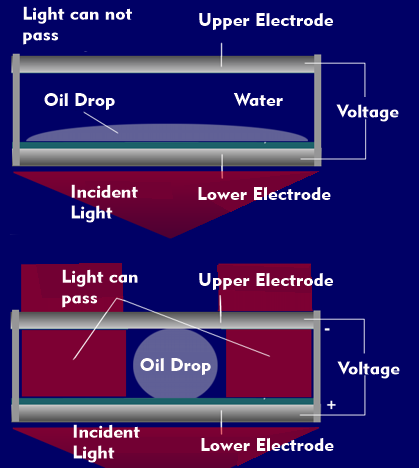electrowetting light valve (ELV)
Electrowetting is a microfluidic phenomenon in which the surface tension of tiny liquid beads is changed by electric fields. The liquid bead is located in a microcell. If this small cell is illuminated with light, the light can pass through the small cell in normal operation. However, if the liquid cell is deformed so that it covers the entire microcell, then light can no longer pass through.
Microfuidic microcells can transmit or block light. They thus fulfill the functions of an optical switch. This application is realized in the Electrowetting Light Valve (ELV) and is suitable as display technology in electrowetting displays.
In the Electrowetting Light Valve, the smallest cell consists of a cavity filled with water. A drop of oil is located in the cavity as a liquid bead. Above and below the microcell are transparent electrodes, to which the deformation voltage is applied, and a water-repellent dielectric. The light is transmitted via a diffuser to the underside of the ELV cell. If no deformation voltage is applied to the electrodes, the oil droplet spreads over the entire bottom of the cell and prevents the ELV cell from transmitting light. If a voltage is applied to the electrodes such that the bottom electrode is positive, then the oil bead deforms into a spherical shape and allows light from the diffuser to pass through the sides.
By applying a voltage, the ELV cell thus becomes an optical switch. If many ELV small cells are irradiated with light of the three primary colors, then a colored light emission can be produced by switching the individual ELV cells, as with luminous displays.

